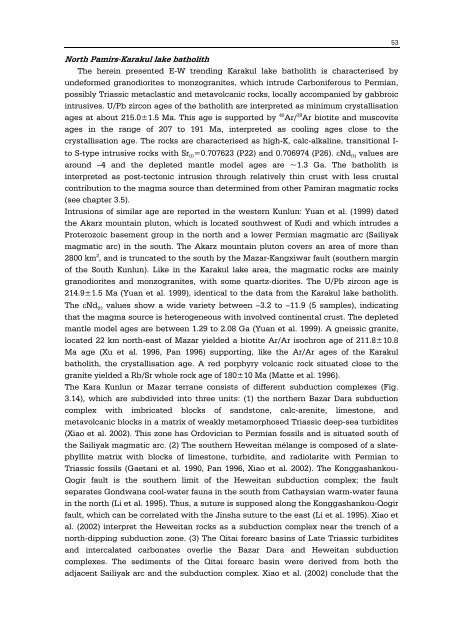tübinger geowissenschaftliche arbeiten (tga) - TOBIAS-lib ...
tübinger geowissenschaftliche arbeiten (tga) - TOBIAS-lib ...
tübinger geowissenschaftliche arbeiten (tga) - TOBIAS-lib ...
Create successful ePaper yourself
Turn your PDF publications into a flip-book with our unique Google optimized e-Paper software.
North Pamirs-Karakul lake batholith<br />
The herein presented E-W trending Karakul lake batholith is characterised by<br />
undeformed granodiorites to monzogranites, which intrude Carboniferous to Permian,<br />
possibly Triassic metaclastic and metavolcanic rocks, locally accompanied by gabbroic<br />
intrusives. U/Pb zircon ages of the batholith are interpreted as minimum crystallisation<br />
ages at about 215.0±1.5 Ma. This age is supported by 40 Ar/ 39 Ar biotite and muscovite<br />
ages in the range of 207 to 191 Ma, interpreted as cooling ages close to the<br />
crystallisation age. The rocks are characterised as high-K, calc-alkaline, transitional I-<br />
to S-type intrusive rocks with Sr (i)=0.707623 (P22) and 0.706974 (P26). �Nd (t) values are<br />
around –4 and the depleted mantle model ages are ~1.3 Ga. The batholith is<br />
interpreted as post-tectonic intrusion through relatively thin crust with less crustal<br />
contribution to the magma source than determined from other Pamiran magmatic rocks<br />
(see chapter 3.5).<br />
Intrusions of similar age are reported in the western Kunlun: Yuan et al. (1999) dated<br />
the Akarz mountain pluton, which is located southwest of Kudi and which intrudes a<br />
Proterozoic basement group in the north and a lower Permian magmatic arc (Sailiyak<br />
magmatic arc) in the south. The Akarz mountain pluton covers an area of more than<br />
2800 km 2 , and is truncated to the south by the Mazar-Kangxiwar fault (southern margin<br />
of the South Kunlun). Like in the Karakul lake area, the magmatic rocks are mainly<br />
granodiorites and monzogranites, with some quartz-diorites. The U/Pb zircon age is<br />
214.9±1.5 Ma (Yuan et al. 1999), identical to the data from the Karakul lake batholith.<br />
The �Nd (t) values show a wide variety between –3.2 to –11.9 (5 samples), indicating<br />
that the magma source is heterogeneous with involved continental crust. The depleted<br />
mantle model ages are between 1.29 to 2.08 Ga (Yuan et al. 1999). A gneissic granite,<br />
located 22 km north-east of Mazar yielded a biotite Ar/Ar isochron age of 211.8±10.8<br />
Ma age (Xu et al. 1996, Pan 1996) supporting, like the Ar/Ar ages of the Karakul<br />
batholith, the crystallisation age. A red porphyry volcanic rock situated close to the<br />
granite yielded a Rb/Sr whole rock age of 180±10 Ma (Matte et al. 1996).<br />
The Kara Kunlun or Mazar terrane consists of different subduction complexes (Fig.<br />
3.14), which are subdivided into three units: (1) the northern Bazar Dara subduction<br />
complex with imbricated blocks of sandstone, calc-arenite, limestone, and<br />
metavolcanic blocks in a matrix of weakly metamorphosed Triassic deep-sea turbidites<br />
(Xiao et al. 2002). This zone has Ordovician to Permian fossils and is situated south of<br />
the Sailiyak magmatic arc. (2) The southern Heweitan mélange is composed of a slatephyllite<br />
matrix with blocks of limestone, turbidite, and radiolarite with Permian to<br />
Triassic fossils (Gaetani et al. 1990, Pan 1996, Xiao et al. 2002). The Konggashankou-<br />
Qogir fault is the southern limit of the Heweitan subduction complex; the fault<br />
separates Gondwana cool-water fauna in the south from Cathaysian warm-water fauna<br />
in the north (Li et al. 1995). Thus, a suture is supposed along the Konggashankou-Qogir<br />
fault, which can be correlated with the Jinsha suture to the east (Li et al. 1995). Xiao et<br />
al. (2002) interpret the Heweitan rocks as a subduction complex near the trench of a<br />
north-dipping subduction zone. (3) The Qitai forearc basins of Late Triassic turbidites<br />
and intercalated carbonates overlie the Bazar Dara and Heweitan subduction<br />
complexes. The sediments of the Qitai forearc basin were derived from both the<br />
adjacent Sailiyak arc and the subduction complex. Xiao et al. (2002) conclude that the<br />
53

















